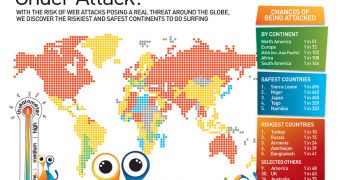Security company AVG has released the results of an interesting study showing the risk of stumbling unto a malicious website around the world. The results show that the risk varies wildly from country to country.
The riskiest place to surf the web is Turkey where one in ten AVG users was faced with a potentially malicious website during the last week of July, when the study was conducted.
At the other end of the scale, just one in 696 users in Sierra Leone was under threat. The great disparity is interesting, but it can be traced back to several factors.
First and foremost, the research doesn't necessarily show the place where it's safest to use the Internet, it's more telling of user behavior than anything.
The great differences between countries can also be attributed to internet use in each region. Africa has seven countries in the top ten safest places in the study, but it also has one of the lowest penetration rates on the planet. With electricity still unavailable to many on the continent, the internet is a luxury enjoy by a few.
At the same time, Japan is the third safest country, with one in 403 users encountering an attack. Japan is one of the most connected countries on the planet so adoption is not an issue here. In fact, it may very well be that the wide reach helps in this regard, users in Japan are generally more tech savvy.
Users in Russia have more to worry about though. With one in 15 users facing an attack, it's the second riskiest country after Turkey.
By continent, North America fares the worst, with one in 51 users at risk of an attack. South America is the safest with the attack rate being one in 164.
AVG looked at data from 127 million computers with its software installed from 144 countries, so it's safe to say that the study had a representative sample.

 14 DAY TRIAL //
14 DAY TRIAL //